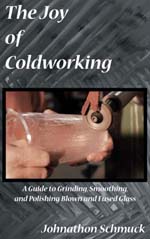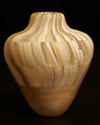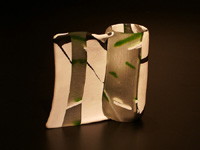Bio - Boards - Panels - Vessels - Jewelry - Home - Resume - Workshops & Exhibitions
Johnathon
Turner Illustrated
with over 250 full color photographs of processes, equipment and
works of art, Johnathon Turner’s The Roll Up - a Statement about the Process The
Roll Up technique involves a combination of kilnforming, hot working,
and cold working the glass. It is a technique for blowing glass that
does not require a furnace full of molten glass; all that is required
to blow a Roll up is a glory hole and two kilns. The main consideration with the Roll up technique is the extreme delicacy of the blowing operation – it requires one to be in a constant, active dialogue with the piece of glass. The whole process enables one to produce precise and intricate design in the glass. These patterns which are unachievable with furnace glass, from the depth of color and design to different patternings on the inside and the outside of the vessel. This precision can cause problems though, as one is sometimes faced with drastic glass-viscosity issues, ie. when a soft color (one that heats up quickly) is adjacent to a hard color (that heats up slowly) making the piece much trickier to control when heated. The main difficulty is that many pieces do not blow out evenly. One often has to futz around to keep the piece on center, even, and round -- concerns that are often minimal when blowing with furnace glass, where the clear gather provides an even and stable layer. Roll ups can easily go out of sorts at the blink of an eye -- a little too much time in the glory hole or a too hard of a puff when blowing. Stretching a Roll up can also be rather pulse quickening. After a successful blow, a piece is cooled slowly to assure proper and full annealling of all the glass. The glass piece will then sit for a day at room temperature before is is ready to be cold worked –- done here by diamond sawing, diamond-wheel cutting, and wet-belt sanding, which when used in conjunction enable one to sculpt the outer surface of the glass. These processes allow one to refine the form and work the surface of a piece until everything looks and feels right. The cold finishing becomes another dialogue with the glass as the surface is removed, and the true form and texture of the piece is revealed. The punty is sawn off, and the piece is flattened on the bottom so it will stand properly. The lip is made flat and then beveled. Rough places are smoothed, and undulations are added elsewhere. Most of the cold work starts with coarse wheels and silicon-carbide belts; these surfaces are then smoothed and refined with finer-grained wheels and belts. The piece is finished by hand lapping with silicon-carbide grit that is rubbed with wet-dry sandpaper on the outer surface of the glass. The hand lapping of the piece to finish often takes several hours during which the qualities of the surface of the glass are observed, both the texture and the appearance. (Chemicals are not used for any finish.) At a certain point, the piece finally says that it is complete; everything is as right as it can get -- just as in "...the idiom of the American architect Louis Kahn, who, in working out the form of a building, used to ask ‘what the building wanted,’ as if there were an internal drive, or what later Greeks called an entelechy, and end state of fulfillment in which the building found the form through which it fulfilled its being." (Arthur C, Danto, After the End of Art, Princeton Press, 1997, pp. 105-6.) Though the Roll up technique is slow and methodical and fraught with hazard, I believe the final results begin to speak of this fulfillment, especially when the piece is seen by one’s hands and felt with one’s eyes. |



